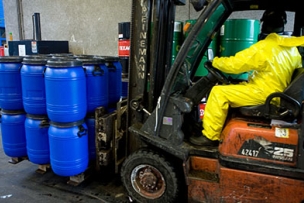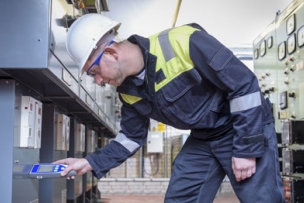A variety of fixed guards and machine guarding devices help prevent injuries in manufacturing facilities.
From saws to drums to presses, a wide variety of machines in a manufacturing facility may need machine guards.
Machine guarding prevents workers from sustaining injuries—like pinches, cuts or even amputations—by keeping them from getting caught in or between moving parts of the machine they’re working on.
A lack of guards, or malfunctioning machine guards, can lead to serious injuries. Green Bay manufacturer Bay Fabrication was hit with more than $200,000 in penalties from the Occupational Safety and Health Administration after two workers received severe injuries within one 10-day period in 2016. One worker’s hand was crushed in a machine with a malfunctioning machine guard and another suffered a partial amputation of a finger in a machine with an unguarded pinch point, according to an article in EHS Today.
Machine Guarding OSHA
A variety of OSHA standards cover the machine guard requirements for different types of machinery used in general industry, including woodworking machinery, abrasive wheel machinery, mechanical power presses and forging machines. Each application requires different types of machine guards.
What Is Machine Guarding and How Does It Work?
Barrier guards are the simplest way to physically prevent a machine operator from entering a dangerous part of a machine by preventing access to it with a barrier.
“Properly designed and installed barrier guards provide the most effective protection to workers,” according to the Guideline for Safeguarding Machinery and Equipment, published by WorkSafeBC. “Fixed barrier guards are the first choice of engineering control to keep workers from contacting hazardous moving parts or to contain harmful fluids and projectiles, particularly when access is not normally required during operation.”
When access is required, there are small and large safety devices and safety features used in manufacturing and machining. WorkSafeBC says devices work in a variety of ways, including by:
- Requiring the machine operator to move out of the danger area
- Stopping the machine if the operator enters the danger area
- Physically restraining the operator from entering the danger area
- Requiring the machine operator to maintain contact with certain controls to keep the machine running
The Many Types of Machine Guards
Here’s a rundown of some of the different types of safeguarding devices available for use on a shop floor:
Emergency and stop controls: A stop control is an “operator control designed to immediately deactivate the clutch control and activate the brake to stop slide motion,” says OSHA on the definitions page for its Machinery and Machine Guarding standard, 29 CFR 1910 Subpart O. These can include belly bars or pressure-sensing mats; if the operator presses against the bar or steps on the mat, the machine will come to a stop, says WorkSafeBC. An emergency stop is a device, often a red button, that immediately stops machine operations. “Because it requires intentional activation, it seldom prevents accidents,” says WorkSafeBC, but instead is used to stop a machine after an accident has occurred.
Enabling devices: “Enabling devices initiate a safety function when a user either squeezes or releases the handle grip switch,” says Banner Engineering. “When continuously activated and used in conjunction with a separate actuating control, these devices allow a machine to function in manual operating mode.”
Holdout or restraint devices: These mechanisms include attachments for an operator’s hands that prevent the operator’s hands from entering the point of operation, says OSHA.
Indicator lights and tower lights: Often available in multiple colors, indicator lights can provide a visible indication of machine status, says Banner Engineering, alerting workers when a machine is in use.
Pullout devices and sweep devices: These devices physically move the machine operator’s hands out of the way when the machine, such as a die or press, closes. A pullout device is attached to the operator’s hands, while a sweep device is not, says OSHA.
Safety interlock switches: Interlocks keep a machine from working when the guard is in an open position, but allow operation when the guard is closed. “If access to a point of operation … is required during normal operation, a movable openable barrier guard interlocked with the machine’s power source can be a reliable and cost-effective solution,” says WorkSafeBC.
Safety light curtains: They’re also known as presence-sensing devices. “A photoelectric transmitter projects an array of synchronized, parallel infrared light beams to a receiver unit. When an opaque object interrupts one or more beams in the sensing field, the control logic of the light curtain sends a stop signal to the guarded machine,” says Automation.com.
Two-hand control devices: These devices require concurrent pressure from both of the operators’ hands. “Similar to the ‘two-hand trip,’ this device keeps the operators’ hands away from the point of operation during the entire machine stroke,” says OSHA.
Preventing Machine Injuries
Though guards and guarding devices can prevent machine injuries, more can be done to improve workplace safety. In particular, loose-fitting clothing, chains, jewelry and long hair can all get entangled in machinery and potentially cause machine injuries, notes Chris Kilbourne at EHS Daily Advisor. Dress codes should prohibit loose clothing and accessories and require that long hair be tied back.
In addition, Kilbourne suggests workers use safe work practices, such as not working alone around machinery in which they could become entangled, and following lockout/tagout procedures. And, he adds, all workers who are around dangerous machinery should be aware of where emergency shut-offs are located and how to use them.
Getting Started: Use Risk Assessments and Machine Surveys
Matt Brenner, vice president of sales for Rockford Systems LLC, says ANSI B11 consensus standards are a good place for manufacturers seeking machine guarding information to start.
“The series consists of nearly three dozen different documents that deal with machine safety and specify requirements for both the manufacturers and users of the machines,” Brenner told OH&S.
But, Brenner adds, on-site risk assessments and machine surveys are a “critical first step.”
“They help to identify the tasks and associated hazards on a machine shop’s equipment,” he says. “In a risk assessment, each machine receives a hazard score indicating the risk level using the ANSI B11.0-2015 safety standard methods. … In a machine survey, each machine is audited for compliance to current safety standards and customized proposals outline the specific products, services, and integrated design engineering solutions that are required to bring the machines into full compliance.”
What types of machine guards does your facility use? Share your stories.




Talk to Us!
Leave a reply
Your email address will not be published. Required fields are marked *